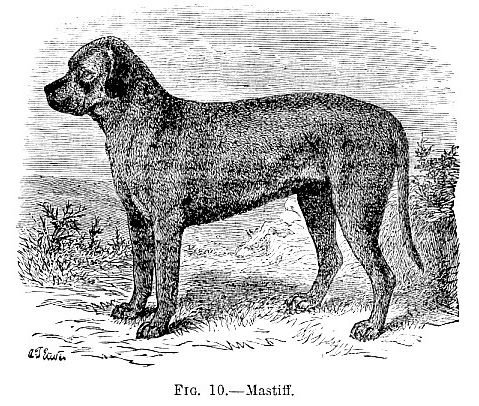The Mastiff equals in courage, while in strength, intelligence, and mildness of disposition it excels, its near ally the bull-dog. It is commonly supposed to have been the breed of large dogs abundant in Britain during Roman times, which were exported in large numbers to Rome for purpose of fighting in the Amphitheater, although Colonel Smith believes that these early British dogs were only bull-dogs of a larger size than the present breed, and that the mastiff was introduced into Britain from the cold regions of Central Asia. It is a large dog, standing 30 inches high at the shoulder, with thick muzzle, pendulous lips, and heavy expression, its ears small and drooping and the tail well developed. It is usually of a buff-colour, with care and muzzle darker. Although fierce in combat, it does not attack without considerable provocation, and it bears the teasing of children with the greatest good nature. When in former times in entered into combat with wild animals, it has been known to engage a bear, a leopard, and a lion, and pull each of them down in succession. At the present time the breed is rarely met with pure, and is chiefly useful as a watch-dog, its sagacity and fidelity in this capacity being well known. While he shows great attachment to man when made his companion, the temper of the mastiff becomes sourced by confinement, and he is the dangerous to strangers. The Thibet Mastiff is larger than the English breed, and its countenance is still heavier. It is the watch0dog of the tribes inhabiting Thibet and the Central Asian table-land, to whom it is strongly attached, although exceedingly savage towards strangers. There is a huge mastiff figured on an Assyrian sculpture, 640 B.C., and Sir H. Rawlinson states states that similar dogs are still important into that country.
The Bulldog is the least sagacious, as well as the most ferocious and obstinate, of the dog tribe. It is smaller than the mastiff, but is strongly built. Its broad, thick head, the projection of the lower jaw beyond and upper disclosing the incisor teeth, the sudden rise of the head from the face, and the scowling expression of the eyes, combine to make the countenance of the bull-dog terrible. Bell points our in his History of British Quadrupeds, the resemblance in the deep chest, the narrow loins, muscular limbs, and stiff tapering tail of the bull-dog to the elegant form of the greyhound. The chief difference appears in the muzzle, a variation which may have suddenly arisen in a single individual, and been perpetuated in its progeny. The ears of the bull-dog are short and semi-erect, and the nostrils distended; the colour varies, being brindled in some, and black and white in others. It is essentially a fighting-dog, and was formerly bred for the brutal sport of bull-baiting, in which its terrible obstinacy usually gained for it the victory. It differs from other dogs in giving no warning of its attack by preliminary barking, and when once it has fixed its teeth into the object of attack, no amount of torture will cause it to relax its hold. Colonel Smith states that he has seen one "pinning down an American bison and holding his nose down till the animal gradually brought forward its hind feet, and, crushing the dog to death, tore his muzzle out of the fangs, most dreadfully mangled;" and there is an instance on record of its returning to the attack on a bull, after each of its feet had been cut-off in succession. The intelligence of this breed has been but slightly developed, and it exhibits little of that attachment to man which characterises other dogs, although it may be said to show a sullen sort of fondness for its master.
The Pug dog, which in form might be described as a miniature bulldog, is probably a monstrous variety, rather than a degenerate form, of the bull-dog. It is, however, wholly unlike the latter in disposition, being timid and good-tempered, and is kept only as a pet, for which its dullness of intellect scarcely fits it.
Read the rest of this article:
Dog - Table of Contents
